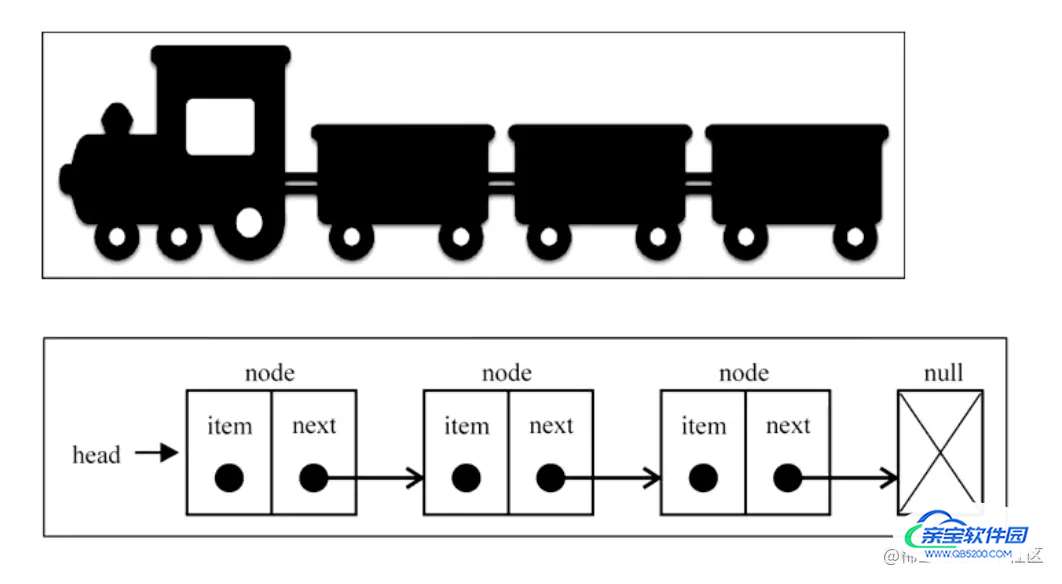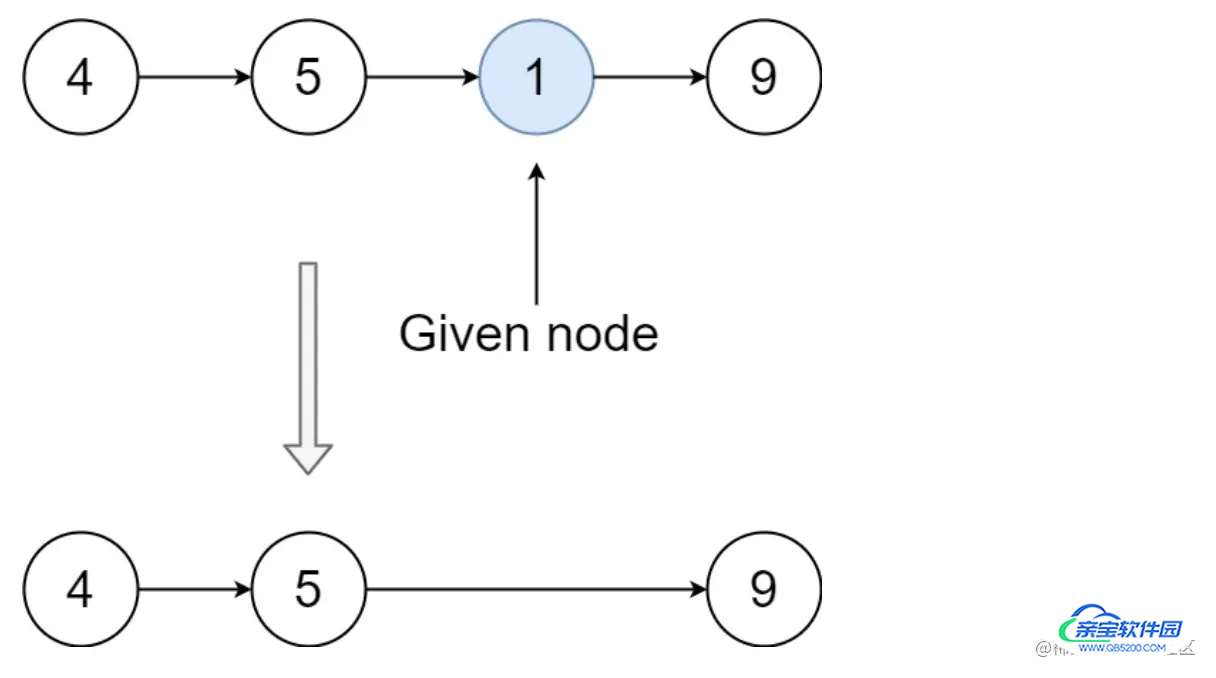js 中没有链表,但可以用 Object 模拟链表链表的火车结构:

链表的常见操作:
append(element):向链表尾部添加一个新的项
insert(value, position):向链表的特定位置插入一个新的项
get(position):获取对应位置的元素
indexOf(element):返回元素在链表中的索引。如果链表中没有该元素则返回 -1
update(position,element):修改某个位置的元素
removeAt(postion):从链表的特定位置移除一项
remove(element):从链表中移除一项
isEmpty():如果链表中不包含任何元素,返回 true,如果链表长度大于等于0返回false
size():返回链表包含的元素个数。与数组的length属性类似
// 1. 创建 Node 节点类
class Node<T> {
value: T;
next: Node<T> | null = null;
constructor(value: T) {
this.value = value;
}
}
// 2. 创建 LinkedList 的类
class LinkedList<T> {
private head: Node<T> | null = null;
private size: number = 0;
get length() {
return this.size;
}
}
代码解析:
Node 类,用于封装每一个节点上的信息(包括和指向下一个节点的引用),它是一个泛型类LinkedList 类,用于表示链表结构size:链表长度
head:链表中的第一个节点
基础的框架搭建好了,我们接下来就来一个个添加方法
向 LinkedList 添加 append(element) 方法
append 方法的作用是向链表尾部添加一个新的项
append(value: T) {
// 1. 根据 value创建一个新节点
const newNode = new Node(value)
// 2. 判断 this.head 是否为 null
if(!this.head) {
this.head = newNode
} else {
let current = this.head
while(current.next) {
current = current.next
}
// 此时 current 指向最后一个节点
current.next = newNode
}
// 3. size++
this.size++
}
为了方便可以看到链表上的每一个节点,我们实现一个 traverse 方法
向 LinkedList 添加 traverse 方法
traverse 方法的作用是 遍历链表
traverse() {
const values: T[] = [];
let current = this.head;
while (current) {
values.push(current.value);
current = current.next;
}
console.log(values.join("->"));
}
测试:
const l = new LinkedList<string>();
l.append("第一个节点");
l.append("第二个节点");
l.append("第三个节点");
l.traverse(); // 第一个节点->第二个节点->第三个节点
向 LinkedList 添加 insert(value, position) 方法
insert方法的作用是向链表的特定位置插入一个新的项
insert(value: T, position: number): boolean {
// 1. 越界判断
if (position < 0 || position >= this.size) return false;
// 2. 根据 value 创建新的节点
const newNode = new Node(value);
// 3. 判断是否需要插入头部
if (position === 0) {
newNode.next = this.head;
this.head = newNode;
} else {
let current = this.head;
let previous: Node<T> | null = null;
let index = 0;
while (index++ < position && current) {
previous = current;
current = current.next;
}
// index === position
newNode.next = current;
previous!.next = newNode;
}
return true;
}
测试:
const l = new LinkedList<string>();
l.append("aaa");
l.append("bbb");
l.append("ccc");
// l.insert("ddd", 0); // 插入头部位置 ddd->aaa->bbb->ccc
// l.insert("ddd", 2); // 插入第二个位置 aaa->bbb->ddd->ccc
// l.insert("ddd", 3); // 插入尾部 aaa->bbb->ccc->ddd
l.traverse();
向 LinkedList 添加 removeAt(postion) 方法
removeAt方法的作用是从链表的特定位置移除一项
removeAt(position: number): T | null {
// 1. 越界判断
if (position < 0 || position > this.size) return null;
// 2. 判断是否删除第一个节点
let current = this.head;
if (position === 0) {
this.head = current?.next ?? null;
} else {
let previous: Node<T> | null = null;
let index = 0;
while (index++ < position && current) {
previous = current;
current = current.next;
}
previous!.next = current?.next ?? null;
}
this.size--;
return current?.value ?? null;
}
测试:
const l = new LinkedList<string>();
l.append("aaa");
l.append("bbb");
l.append("ccc");
// console.log(l.removeAt(0)); // aaa
// console.log(l.removeAt(1)); // bbb
// console.log(l.removeAt(2)); // ccc
// console.log(l.removeAt(3)); // null
l.traverse();
向 LinkedList 添加 get(postion) 方法
get方法的作用是获取对应位置的元素
get(position: number): T | null {
// 越界问题
if (position < 0 || position >= this.size) return null;
// 2. 查找元素
let index = 0;
let current = this.head;
while (index++ < position && current) {
current = current?.next;
}
// index === position
return current?.value ?? null;
}
测试:
const l = new LinkedList<string>();
l.append("aaa");
l.append("bbb");
l.append("ccc");
console.log(l.get(0)); // aaa
console.log(l.get(1)); // bbb
console.log(l.get(2)); // ccc
console.log(l.get(3)); // null
到这里,我们发现上面的代码在 通过 position 获取节点的逻辑 上有很多重复的地方,现在我们通过添加 getNode 方法来重构一下
向 LinkedList 添加 getNode(postion) 私有方法
getNode方法的作用是获取对应位置的节点
// 封装私有方法
// 根据 position 获取得到当前的节点
private getNode(position: number): Node<T> | null {
let index = 0;
let current = this.head;
while (index++ < position && current) {
current = current?.next;
}
return current;
}
有了这个方法,我们就可以对 get removeAt insert 方法进行重构了
removeAt 进行重构 removeAt(position: number): T | null {
// 1. 越界判断
if (position < 0 || position > this.size) return null;
// 2. 判断是否删除第一个节点
let current = this.head;
if (position === 0) {
this.head = current?.next ?? null;
} else {
- let previous: Node<T> | null = null;
- let index = 0;
-
- while (index++ < position && current) {
- previous = current;
- current = current.next;
- }
- previous!.next = current?.next ?? null;
+ let previous = this.getNode(position - 1);
+ current = previous?.next ?? null;
+ previous!.next = previous?.next?.next ?? null;
}
this.size--;
return current?.value ?? null;
}
get 进行重构 get(position: number): T | null {
// 越界问题
if (position < 0 || position >= this.size) return null;
// 2. 查找元素
- let index = 0;
- let current = this.head;
- while (index++ < position && current) {
- current = current?.next;
- }
+ let current = this.getNode(position);
return current?.value ?? null;
}
insert 进行重构 insert(value: T, position: number): boolean {
// 1. 越界判断
if (position < 0 || position > this.size) return false;
// 2. 根据 value 创建新的节点
const newNode = new Node(value);
// 3. 判断是否需要插入头部
if (position === 0) {
newNode.next = this.head;
this.head = newNode;
} else {
- let current = this.head;
- let previous: Node<T> | null = null;
- let index = 0;
-
- while (index++ < position && current) {
- previous = current;
- current = current.next;
- }
-
- // index === position
- newNode.next = current;
- previous!.next = newNode;
+ const previous = this.getNode(position - 1);
+ newNode.next = previous?.next ?? null;
+ previous!.next = newNode;
}
return true;
}
测试一把,都没问题
const l = new LinkedList<string>();
l.append("aaa");
l.append("bbb");
l.append("ccc");
// console.log(l.removeAt(0)); // aaa
// console.log(l.removeAt(1)); // bbb
// console.log(l.removeAt(2)); // ccc
// console.log(l.removeAt(3)); // null
// console.log(l.get(0)) // aaa
// console.log(l.get(1)) // bbb
// console.log(l.get(2)) // ccc
// console.log(l.get(3)) // null
// l.insert("ddd", 0); // ddd->aaa->bbb->ccc
// l.insert("ddd", 1); // aaa->ddd->bbb->ccc
// l.insert("ddd", 2); // aaa->bbb->ddd->ccc
// l.insert("ddd", 3); // aaa->bbb->ccc->ddd
// l.insert("ddd", 4); // aaa->bbb->ccc
l.traverse();
向 LinkedList 添加 update(position,element) 方法
update方法的作用是修改某个位置的元素
update(value: T, position: number):boolean {
if (position < 0 || position >= this.size) return false;
// 获取对应位置的节点,直接更新即可
const currentNode = this.getNode(position)
currentNode!.value = value
return true
}
测试:
const l = new LinkedList<string>();
l.append("aaa");
l.append("bbb");
l.append("ccc");
l.traverse(); // aaa->bbb->ccc
l.update("ddd", 1); // aaa->ddd->ccc
l.traverse();
向 LinkedList 添加 indexOf(element) 方法
indexOf方法的作用是返回元素在链表中的索引。如果链表中没有该元素则返回 -1
indexOf(value: T) {
// 从第一个节点开始,向后遍历
let current = this.head;
let index = 0;
while (current) {
if (current.value === value) {
return index;
}
current = current.next;
index++;
}
return -1;
}
测试:
const l = new LinkedList<string>();
l.append("aaa");
l.append("bbb");
l.append("ccc");
console.log(l.indexOf("aaa"));
console.log(l.indexOf("bbb"));
console.log(l.indexOf("ccc"));
向 LinkedList 添加 remove(element) 方法
remove方法的作用是从链表中移除一项
remove(value: T): T | null {
const index = this.indexOf(value);
return this.removeAt(index);
}
测试:
const l = new LinkedList<string>();
l.append("aaa");
l.append("bbb");
l.append("ccc");
l.remove('bbb')
l.traverse() // aaa->ccc
向 LinkedList 添加 isEmpty() 方法
isEmpty方法的作用是如果链表中不包含任何元素,返回 true,如果链表长度大于等于 0 返回 false
isEmpty(): boolean {
return this.size === 0;
}
这是 Leetcode 上的第 707 道题,难度为:中等
设计链表的实现。您可以选择使用单链表或双链表。单链表中的节点应该具有两个属性:val 和 next。val 是当前节点的值,next 是指向下一个节点的指针/引用。如果要使用双向链表,则还需要一个属性 prev 以指示链表中的上一个节点。假设链表中的所有节点都是 0-index 的。
在链表类中实现这些功能:
get(index):获取链表中第 index 个节点的值。如果索引无效,则返回-1。addAtHead(val):在链表的第一个元素之前添加一个值为 val 的节点。插入后,新节点将成为链表的第一个节点。addAtTail(val):将值为 val 的节点追加到链表的最后一个元素。addAtIndex(index,val):在链表中的第 index 个节点之前添加值为 val 的节点。如果 index 等于链表的长度,则该节点将附加到链表的末尾。如果 index 大于链表长度,则不会插入节点。如果index小于0,则在头部插入节点。deleteAtIndex(index):如果索引 index 有效,则删除链表中的第 index 个节点。示例:
MyLinkedList linkedList = new MyLinkedList(); linkedList.addAtHead(1); linkedList.addAtTail(3); linkedList.addAtIndex(1,2); //链表变为1-> 2-> 3 linkedList.get(1); //返回2 linkedList.deleteAtIndex(1); //现在链表是1-> 3 linkedList.get(1); //返回3
提示:
0 <= index, val <= 1000LinkedList 库。get, addAtHead, addAtTail, addAtIndex 和 deleteAtIndex 的操作次数不超过 2000。这道题的答案在第二章就已经给出了,我们只需要进行一些修改即可
class Node {
value: number;
next: Node | null = null;
constructor(value: number) {
this.value = value;
}
}
class MyLinkedList {
private head: Node | null = null;
private size: number = 0;
constructor() {}
private getNode(position: number): Node | null {
let index = 0;
let current = this.head;
while (index++ < position && current) {
current = current?.next;
}
return current;
}
get(index: number): number {
if (index < 0 || index >= this.size) return -1;
let current = this.getNode(index);
return current!.value;
}
addAtHead(val: number): void {
const newNode = new Node(val);
if (!this.head) {
this.head = newNode;
} else {
newNode.next = this.head;
this.head = newNode;
}
this.size++;
}
addAtTail(val: number): void {
const newNode = new Node(val);
if (!this.head) {
this.head = newNode;
} else {
let current = this.getNode(this.size - 1);
current!.next = newNode;
}
this.size++;
}
addAtIndex(index: number, val: number): void {
if (index > this.size) return;
if (index <= 0) {
this.addAtHead(val);
} else {
const newNode = new Node(val);
const previous = this.getNode(index - 1);
newNode.next = previous?.next ?? null;
previous!.next = newNode;
}
this.size++;
}
deleteAtIndex(index: number): void {
if (index < 0 || index >= this.size) return;
let current = this.head;
if (index === 0) {
this.head = current?.next ?? null;
} else {
const previous = this.getNode(index - 1);
previous!.next = previous?.next?.next ?? null;
}
this.size--;
}
}
复杂度分析:
时间复杂度:
初始化消耗 O(1)
get 消耗 O(index)
addAtHead 消耗 O(1)
addAtTail 消耗 O(n),其中 n 为链表当前长度
addAtIndex 消耗 O(index)
deleteAtIndex 消耗 O(index - 1)
O(1),总体空间复杂度为 O(n),这是 Leetcode 上的第 237 道题,难度为:中等
有一个单链表的 head,我们想删除它其中的一个节点 node。
给你一个需要删除的节点 node 。你将 无法访问 第一个节点 head。
链表的所有值都是 唯一的,并且保证给定的节点 node 不是链表中的最后一个节点。
删除给定的节点。注意,删除节点并不是指从内存中删除它。这里的意思是:
node 前面的所有值顺序相同。node 后面的所有值顺序相同。自定义测试:
head 和要给出的节点 node。node 不应该是链表的最后一个节点,而应该是链表中的一个实际节点。示例 1:

输入: head = [4,5,1,9], node = 5
输出: [4,1,9]
解释: 指定链表中值为 5 的第二个节点,那么在调用了你的函数之后,该链表应变为 4 -> 1 -> 9
示例 2:

输入: head = [4,5,1,9], node = 1
输出: [4,5,9]
解释: 指定链表中值为 1 的第三个节点,那么在调用了你的函数之后,该链表应变为 4 -> 5 -> 9
提示:
[2, 1000]-1000 <= Node.val <= 1000node 是 链表中的节点 ,且 不是末尾节点删除节点的操作我们其实之前就已经实现了的,我们只要拿到要删除节点的前一个节点,将前一个节点的 next 指向要删除节点的下一个节点即可。 但是这道题有一个问题就是,我们拿不到要删除前点的上一个节点。
思路:
我们可以将要删除的节点的值赋值成它的下一个节点就行了,这样就将问题从删除某个节点转换成了删除某个节点的后一个节点,这样的好处就是我们能拿到要删除节点的前一个节点。
/**
* Definition for singly-linked list.
* class ListNode {
* val: number
* next: ListNode | null
* constructor(val?: number, next?: ListNode | null) {
* this.val = (val===undefined ? 0 : val)
* this.next = (next===undefined ? null : next)
* }
* }
*/
/**
Do not return anything, modify it in-place instead.
*/
function deleteNode(node: ListNode | null): void {
node.val = node.next.val;
node.next = node.next.next;
}
复杂度分析
O(1)。O(1)。这是 Leetcode 上的第 206 道题,难度为:中等
这道题可以用栈来解决,利用栈的 后进先出 的特性。
思路:先依次将数据 push 进栈中,再一次从栈中 pop 出数据,拼接 pop 出来的元素成一个新的链表。
function reverseList(head: ListNode | null): ListNode | null {
// head 本身为 null 时 不需要处理
if (head === null) return null;
// 只有一个节点
if (!head.next) return head;
// 数组模拟栈结构
const stack: ListNode[] = [];
let current: ListNode | null = head;
while (current) {
stack.push(current);
current = current.next;
}
// 依次从栈结构中取出元素,放到一个新的链表中
const newHead: ListNode = stack.pop()!
let newHeadCurrent = newHead
while(stack.length) {
const node = stack.pop()!
newHeadCurrent.next = node
newHeadCurrent = newHeadCurrent.next
}
newHeadCurrent.next = null
return newHead
}
复杂度分析:
O(2n) ,n 为链表的长度,因为要遍历两次链表O(n),额外需要使用栈这种结构假设链表为 1 ➡️ 2 ➡️ 3 ➡️ 4 ➡️ ∅,我们想要把它改成 ∅ ⬅️ 1 ⬅️ 2 ⬅️ 3 ⬅️ 4
思路:在遍历链表时,将当前节点的 next 指针改为指向前一个节点。由于节点没有引用其前一个节点,因此必须事先存储其前一个节点。在更改引用之前,还需要存储后一个节点。最后返回新的头引用。
function reverseList(head: ListNode | null): ListNode | null {
// 1. 判断节点为 null,或者只要一个节点,那么直接返回即可
if (head === null || head.next === null) return head;
// 2. 反转链表结构
let newHead: ListNode | null = null
while(head) {
const current: ListNode | null = head.next
head.next = newHead
newHead = head
head = current
}
return newHead
}
复杂度分析
O(n),其中 n 是链表的长度。需要遍历链表一次。O(1)。递归版本稍微复杂一些,其关键在于反向工作。
思路:
假如我们有一个链表 1 -> 2 -> 3 -> 4
如果我们想反转 1 <- 2 就必须先将反转 2 <- 3,因为如果我们将 1 -> 2 反转成 1 <- 2 后,那么 2 后边的节点就再也拿不到了。按照上面的逻辑递归,我们需要先将最后的 3 -> 4 反转成 3 <- 4 在反转前面的节点。
function reverseList(head: ListNode | null): ListNode | null {
// 1. 判断节点为 null,或者只要一个节点,那么直接返回即可
if (head === null || head.next === null) {
return head
};
const newHead = reverseList(head.next);
head.next.next = head;
head.next = null;
return newHead;
}
复杂度分析:
O(n),其中 n 是链表的长度。需要对链表的每个节点进行反转操作。O(n),其中 n 是链表的长度。空间复杂度主要取决于递归调用的栈空间,最多为 n 层。